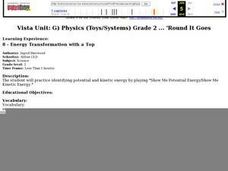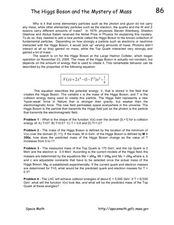Curated OER
Fall 2004 Midterm Exam #1, Parts A & B
First year physics learners show what they know about electric potential, circuits, power, current, and voltage on this midterm exam. It consists of a multiple choice section, some true or false questions, and two multi-step problems to...
Curated OER
Pendulums
First-time physicists experiment with pendulums in this physics lesson. They vary the weight of the bob, record how long each takes to complete ten period swings, and then calculate the time for one period. They repeat the procedure,...
Curated OER
Energy Transformation with a Top
Second graders examine both potential and kinetic energy. After discussing the difference and examples of potential and kinetic energy, they participate in a game of "Show Me Potential Energy/Show Me Kinetic Energy" using toy tops.
Curated OER
Energy Transformation with Simple Machines
First graders identify both potential and kinetic energy in a game they play in the classroom. They listen as the teacher explains the difference between potential and kinetic energy when observing a simple machine. Using simple...
Curated OER
Energy Transformation with Balance Toys
Students explore and identify the concepts of potential and kinetic energy. They define kinetic and potential energy and discuss examples of each. Students then play a game involving balance toys, demonstrating both kinetic and potential...
Curated OER
K.E. & P.E.
For this kinetic and potential energy worksheet, students complete math word problems about kinetic and potential energy. Students complete 10 questions total.
Curated OER
Boarding School
Students discuss conservation of energy using a skateboarder in the halfpipe or a person on a roller coaster as an example. Using mathematical equations, students examine potential and kinetic energy of the examples. Lesson is completed...
Curated OER
Conservation of Energy
The 4-stroke engine is the first example of this Power Point. Other examples include skating and a demolition machine. The potential energy and work involved that is then converted to another form, is presented in slides that are...
Curated OER
Applied Science -Physics (2B) Pre Lab
Second graders look at different types of energy. In this energy lesson plan, 2nd graders define energy and the difference between kinetic and potential energy. They see examples with falling books and a slinky.
Curated OER
The Bouncing Ball
Students investigate potential energy. In this potential energy lesson, students do an experiment with a bouncing ball. Students mark how high the ball bounces when it is dropped and record their results. Students discuss...
Curated OER
Black Holes...Hot Stuff!...VIII
In this black holes worksheet, students solve three problems about black holes using given equations for determining the temperature of the gases in a black hole and the visible light from the black hole at given temperatures.
Curated OER
Energy Transformation
In this energy transformation worksheet, students earn extra credit by choosing a energy transforming toy or ride at an amusement park and analyzing the energy transformation involved in its movement. Students draw a diagram to...
Curated OER
Falling into a Black Hole
In this black hole activity, students solve 3 problems given the equation used to determine the speed of a falling body using its mass, the constant of gravitation and the distance it will travel.
Curated OER
The Higgs Boson and The Mystery of Mass
In this Higgs Boson and mass instructional activity, learners read about the differences in elementary particle mass and they solve 4 equations using a given equation for the potential energy in the Higgs Boson field.
Curated OER
Exploring the Ares 1-X Launch-Energy Changes
In this energy changes worksheet, students solve 5 problems using the formulas for potential and kinetic energy related to baseball energy, coasting rocket energy and the energy of falling stones.
Curated OER
Energy
In this energy worksheet, students answer 17 questions about kinetic and potential energy. They calculate potential energy, they write formulas for kinetic energy, they solve equations for kinetic energy and they identify types of energy...
Curated OER
Potential and Kinetic Energy
In this kinetic and potential energy worksheet, students read about energy of position and energy of motion and are given the equations to find each. Students match 11 terms with their definitions about both types of energy and the...
Curated OER
Heating/Cooling Curve
In this heating and cooling curve worksheet, students use a given graph of a substance being heated from a solid to a liquid and then a gas over time. They use the graph to answer eleven questions about the phases of the substance and...
Curated OER
Transition State Theory
In this transition state theory learning exercise, high schoolers read about chemical reactions and the theory for how chemical reactions proceed. They answer questions about the activated complex, the activation energy and the collision...
Curated OER
Integrating Chemistry-Chemical Reactions
In this chemical reactions learning exercise, students read about different types of chemical reactions, potential and chemical energy. They answer three questions about their reading.
Curated OER
Work, Energy, and Power
For this energy worksheet, students determine how much work a person an object does, the potential energy of an object, the amount of power being exerted on an object. This worksheet has 16 word problems.
Curated OER
Potential and Kinetic Energy
In this energy worksheet, students read about potential energy and kinetic energy. Then students complete 16 matching, 8 fill in the blank, and 9 word problems.
Curated OER
What is Energy?
In this energy worksheet, students will determine if 7 examples represent kinetic energy or potential energy. Then students will study an illustration of a child coming down a slide and answer 5 energy questions based on the illustration.
Curated OER
What is Energy?
In this potential and kinetic energy worksheet, students will learn how potential energy and kinetic energy are used to make a roller coaster go. Then students will complete 2 short answer questions based on what they read.

























